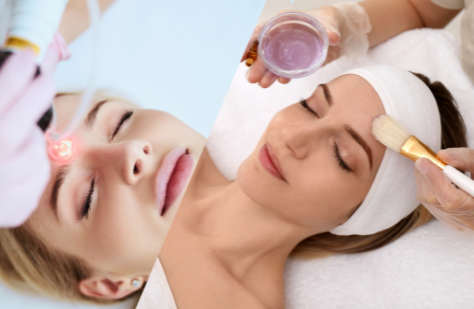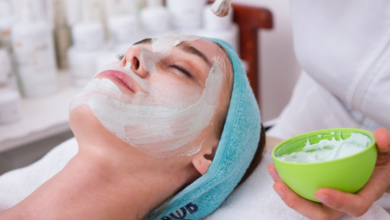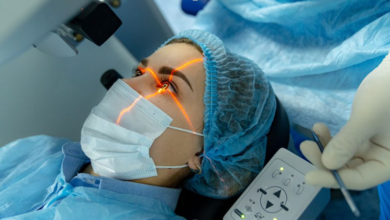Chemical Peels vs Laser for Pigmentation – Which Is Better?

Skin pigmentation concerns, such as dark spots, melasma, and uneven tone, affect many individuals. These issues are often due to sun exposure, hormonal changes, or aging. While cosmetic creams may help to a certain extent, advanced dermatological procedures like chemical peels and laser therapy offer more reliable solutions. Both treatments aim to reduce pigmentation and restore clarity to the skin, but they work in very different ways.
What Are Chemical Peels And How Do They Work?
Chemical peels are skin-resurfacing treatments that use acids, such as glycolic, salicylic, or trichloroacetic acid, to exfoliate the top layers of skin. By removing damaged cells, peels encourage the growth of healthier, brighter skin. Depending on the type and strength, chemical peels can target superficial pigmentation or penetrate deeper to address stubborn patches. The process is quick, with minimal downtime for lighter peels. However, deeper peels may require recovery time. Dermatologists often recommend chemical peels for patients seeking gradual yet noticeable improvements in pigmentation.
Types Of Chemical Peels For Pigmentation
Not all chemical peels are the same. They are generally divided into three categories:
- Superficial Peels: Mild acids that lightly exfoliate the skin surface.
- Medium Peels: Penetrate deeper layers to reduce stubborn pigmentation.
- Deep Peels: Stronger solutions targeting severe skin concerns.
Each type comes with its own benefits and recovery timelines. For instance, superficial peels require minimal downtime but may need multiple sessions, whereas deeper peels deliver more dramatic results in fewer sessions but involve longer healing. The choice depends on skin type, pigmentation severity, and desired outcomes.
How Laser Treatments Target Pigmentation
Laser treatments use focused beams of light to break down excess melanin in the skin. Unlike peels, which exfoliate layers, lasers directly target pigment clusters without affecting surrounding tissue. Popular methods include Q-switched lasers and fractional lasers, each designed for different pigmentation issues. Results are often quicker and more precise compared to peels. However, laser sessions may require strict post-care, such as sun protection, to prevent recurrence. Many patients with stubborn pigmentation that doesn’t respond to peels often turn to laser therapy for better outcomes.
Comparing Effectiveness
Both treatments can be effective, but their success depends on the type of pigmentation and individual skin condition. Chemical peels are generally better for mild to moderate pigmentation and overall skin rejuvenation, while lasers are ideal for deeper or resistant pigmentation. Some dermatologists recommend a combination approach, where peels prepare the skin, and lasers provide targeted correction. Choosing between the two often comes down to personal goals, tolerance for downtime, and the dermatologist’s recommendations.
Safety And Side Effects Of Both Treatments
Safety is a critical factor when deciding on pigmentation treatments. Chemical peels may cause temporary redness, peeling, or sensitivity, especially with stronger formulas. Lasers, on the other hand, can lead to mild swelling, redness, or in rare cases, hyperpigmentation if not administered properly. Consulting a skilled dermatologist minimizes these risks. Both treatments require post-care, such as sunscreen use and gentle skincare routines, to protect results. When performed by trained professionals, both chemical peels and lasers are considered safe and effective solutions for pigmentation issues.
Cost Considerations And Accessibility
Cost plays an important role in choosing a treatment. Chemical peels are generally more affordable and accessible, with prices depending on the type and number of sessions needed. Lasers, while more expensive, may require fewer sessions for noticeable results. Accessibility also matters, chemical peels are available at most dermatology clinics, while advanced laser technology may be limited to specialized centers. Patients should weigh short-term affordability against long-term effectiveness to decide which treatment aligns with their budget and expectations.
Read Also: Guardians of Health: Maintaining Safety in Drug Manufacturing
Which Treatment Works Best For Different Skin Types?
Skin type and sensitivity are major factors when choosing between peels and lasers. Chemical peels are often recommended for oily or acne-prone skin since they also help unclog pores. Lasers, however, may be better for stubborn pigmentation on deeper skin tones but require extra caution to avoid post-treatment discoloration. Dermatologists usually customize treatment plans based on:
- Skin tone and sensitivity
- Type of pigmentation (melasma, freckles, sun damage)
- Desired recovery time
When it comes to pigmentation, one solution doesn’t fit all. A dermatologist can assess skin health, discuss concerns, and recommend the most suitable treatment. Patients in Ahmedabad benefit from access to advanced dermatology centers offering both procedures. Known for combining expertise with modern facilities. Those seeking safe and reliable care often consider Chemical Peel Treatment in Ahmedabad, as clinics here provide quality solutions and skilled professionals and advanced technology.
Long-Term Results And Maintenance
Neither treatment offers permanent results without proper care. Pigmentation can return if sun protection and maintenance routines are ignored. Chemical peels may require ongoing sessions to sustain results, while lasers may deliver longer-lasting outcomes but still demand maintenance. Patients should follow dermatologist-recommended skincare, avoid excessive sun exposure, and maintain healthy habits. Combining treatments with a consistent skincare regimen ensures better long-term control over pigmentation. Regular follow-ups also allow dermatologists to adjust treatments as skin conditions evolve over time.





